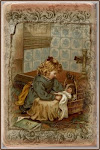
While the most widely known American version of Santa Clause is often credited to the 1823 Clement Clark Moore poem "The Night Before Christmas," Santa as we currently know him can be traced back even further, with origins dating as far back as the 4th century. An early Dutch depiction is based on legend of Sinter Klaas, which was brought by Dutch natives when they settled in New York in the 17th century. In "History of New York" famed author Washington Irving, writing under the pseudonym Diedrick Knickerbocker, provided detailed information about the Dutch version of Saint Nicholas. This Saint Nicholas would arrive on horseback every year on the eve of St, Nicholas. The Christian-era Santa Claus owes much of it's origins to Bishop Nicholas of Smyrna (now Turkey). Rich and generous, Bishop Nicholas was said to bring joy to poor children by throwing gifts in their windows. The legendary Santa Claus has evolved over the years, and it should come as no surprise that he continues to enchant children no matter the era.

Can you believe people use to worship evergreen holly as a sign of eternal life because it did not brown or die in the winter?...Some religious groups say that the crown of thorns placed on Jesus' head was made of holly. We now place wreaths on doors or hallways to create a festive atmosphere during the holiday season.
 Did you realize that mistletoe is rarely used in churches because it comes from the ancient Druid ceremony celebrating winter solstice?...A girl would stand beneath the hanging mistletoe and a boy would walk up, pick a berry and then kiss her...When the berries were gone...no more kisses..
Did you realize that mistletoe is rarely used in churches because it comes from the ancient Druid ceremony celebrating winter solstice?...A girl would stand beneath the hanging mistletoe and a boy would walk up, pick a berry and then kiss her...When the berries were gone...no more kisses..
STOCKINGS:
Do you know why we hang stockings on the fireplace?...Long ago it was said that Saint Nicholas threw three coins down a chimney of the home of three poor sisters. Each of the coins landed inside separate stockings left on the hearth to dry. It is now a modern tradition to hang stockings there.
COOKIES:
There is no exact date recorded but the idea of leaving cookies for Santa started sometimes in the 1930's. Naughty kids use them to bribe Santa at the last minute and nice kids use them as a way of thanking him for all his hard work on Christmas Eve.
CHRISTMAS CARDS:

The first known Christmas card is printed on the front cover with a date of 1843. The original was in muted colours, hand painted, printed and sold for 1/- each (5p) - a lot of money in those days. Despite the date on this card, encyclopedias say that Christmas cards were first sold in 1846!
By the 1860s the idea of sending cards had caught on as they were able to be produced much more cheaply with the invention of less expensive colour printing. The first Christmas cards had lace and flowery borders, but then they changed to more familiar designs.
The robin became very popular as were Victorian snow scenes, religious pictures, holly, Christmas trees etc. Many similar scenes are reproduced in our cards today.
CAROLING:

The custom of singing Christmas carols is said to have come from 13th century Italy where a man named St Francis of Assisi led songs of praise. It is very bad luck to send carolers away empty handed. It is customary to offer food, drink or even a little money.
CHRISTMAS TREE:

The very first trees were oak, the very same tree used for the Yule Log. Trees have been a symbol of good luck since the Middle Ages. In Germany whenever someone would build a house, a small evergreen tree would be nailed to the highest beam. Soon people began bringing the tree inside during Christmastime and decorating it. When the German immigrants came to the United States, they brought this tradition with them.
CHRISTMAS LIGHTS:

The very first person to have Christmas lights on their tree was Edward Johnson who worked for Thomas Edison. It would be awhile however before the general public could purchase similar lights. The first strands to be mass-produced came from Ever Ready in the early 1900's.
CANDY CANES:

In the year 1670 the local choirmaster at the Cologne Cathedral gave his young singers sugar sticks to keep them quit during the long ceremony. he had the candy bent in the shape of shepherd's crooks to celebrate the festive occasion. In the 1920's Bob McCormack made candy canes by hand for his friends and family but it took too long to bend them and only a few people could enjoy them. In the 1950's, Gregory Keller, invented a machine that made lots of candy canes at the same time, Bob's Candies, Inc. became the largest maker of candy canes in the world. It was only in the early 1900's that red stripes were added and peppermint became the standered flavor.
EGGNOG:

Did you know eggnog use to be made with beer?...In the 17th century a strong ale called 'nog' was very popular in Britain around the holidays. It was made from beer, sugar, egg yolks, lemon rinds and cinnamon. Later in the 19th century North Americans took the French version of the drink called 'Lait de Poule', made from milk, sugar and egg yolks and added spirits. With the addition of brandy, rum or sherry, we have our modern day eggnog.
I hope you have enjoyed reading about some of our holiday traditions.











.jpg)






































































.jpg)


























.JPG)















4 comments:
Merry Christmas Sue. I enjoyed reading that.
Hugs Pam
WOWOW I have learn so much from reading your blog... I don't need to subscribe to magazines any more..
Thanks for all the info.
deb
Sue, I love your blog so much.... I know we are kindred spirits! We could sit and talk for hours upon hours!!!
Hugs and blessings!
Yvette
OH how beautiful this is - Thanks for sharing > Have a Blessed
Christmas Kathy - ga
Post a Comment